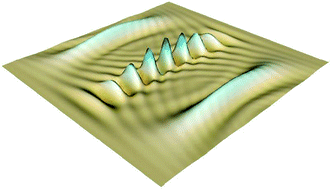New insights into the semiclassical Wigner treatment of photodissociation dynamics
Abstract
The semiclassical Wigner treatment of Brown and Heller [J. Chem. Phys. 1981, 75, 186] is applied to direct triatomic (or triatomic-like polyatomic) photodissociations with the aim of accurately predicting final state distributions at relatively low computational cost, and having available a powerful interpretative tool. For the first time, the treatment takes rotational motions into account. The proposed formulation closely parallels the quantum description as far as possible. An approximate version is proposed, which is still accurate while numerically much more efficient. In addition to being weighted by usual vibrational Wigner distributions, final phase space states appear to be weighted by new rotational Wigner distributions. These densities have remarkable structures clearly showing that classical trajectories most contributing to rotational state j are those reaching the products with a rotational angular momentum close to [j(j + 1)]1/2 (in ℏ units). The previous methods involve running trajectories from the reagent molecule onto the products. The alternative backward approach [L. Bonnet, J. Chem. Phys., 2010, 133, 174108], in which trajectories are run in the reverse direction, is shown to strongly improve the numerical efficiency of the most rigorous method in addition to being state-selective, and thus, ideally suited to the description of state-correlated distributions measured in velocity imaging experiments. The results obtained by means of the previous methods are compared with rigorous quantum results in the case of Guo's triatomic-like model of methyl iodide photodissociation [J. Chem. Phys., 1992, 96, 6629] and close agreement is found. In comparison, the standard method of Goursaud et al. [J. Chem. Phys., 1976, 65, 5453] is only semi-quantitative.

- This article is part of the themed collection: Spectroscopy and dynamics of medium-sized molecules and clusters

 Please wait while we load your content...
Please wait while we load your content...